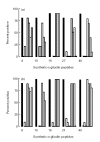Anti-alpha-gliadin antibodies (AGA) in the serum of coeliac children and controls recognize an identical collection of linear epitopes of alpha-gliadin
- PMID: 9822275
- PMCID: PMC1905116
- DOI: 10.1046/j.1365-2249.1998.00722.x
Anti-alpha-gliadin antibodies (AGA) in the serum of coeliac children and controls recognize an identical collection of linear epitopes of alpha-gliadin
Abstract
Anti-gliadin antibodies can be found in the serum of patients with overt and subclinical coeliac disease, but also in that of some controls. The aim of the present study was to identify the linear epitopes of the alpha-gliadin molecule to which the humoral response is directed. Therefore, the IgG and IgA antibody reactivity against an overlapping set of synthetic peptides covering the entire sequence of alpha-gliadin was measured in the sera from patients with coeliac disease, from controls with elevated titres of anti-gliadin antibodies and from healthy children using an ELISA technique. The antibodies mainly recognize peptides derived from the N-terminal region of alpha-gliadin, containing the motif QPFXXQXPY. Reactivity was also detected against two other synthetic peptides, which do not contain this motif and represent a sequence encoded further to the C-terminal region of alpha-gliadin. Anti-gliadin antibodies in sera from patients with coeliac disease and from controls recognize the same linear epitopes. Thus, serological investigation of the specificity of these antibodies using a peptide ELISA does not allow discrimination between patients and controls.
Figures



Similar articles
-
B cell epitopes of gliadin.Clin Exp Immunol. 2000 Aug;121(2):248-54. doi: 10.1046/j.1365-2249.2000.01312.x. Clin Exp Immunol. 2000. PMID: 10931138 Free PMC article.
-
Beta structure motif recognition by anti-gliadin antibodies in coeliac disease.FEBS Lett. 1998 May 1;427(1):36-40. doi: 10.1016/s0014-5793(98)00388-3. FEBS Lett. 1998. PMID: 9613595
-
Identification of common epitopes on gliadin, enterocytes, and calreticulin recognised by antigliadin antibodies of patients with coeliac disease.Gut. 1999 Feb;44(2):168-73. doi: 10.1136/gut.44.2.168. Gut. 1999. PMID: 9895374 Free PMC article.
-
Serology of coeliac disease: early diagnosis and therapeutic impact.Acta Gastroenterol Belg. 1995 Sep-Dec;58(5-6):388-96. Acta Gastroenterol Belg. 1995. PMID: 8775995 Review.
-
Anti-gliadin antibodies.J Pediatr Gastroenterol Nutr. 1991 Feb;12(2):150-8. doi: 10.1097/00005176-199102000-00002. J Pediatr Gastroenterol Nutr. 1991. PMID: 2051264 Review. No abstract available.
Cited by
-
Interplay between genetics and the environment in the development of celiac disease: perspectives for a healthy life.J Clin Invest. 2001 Nov;108(9):1261-6. doi: 10.1172/JCI14344. J Clin Invest. 2001. PMID: 11696566 Free PMC article. No abstract available.
-
Determination of B-Cell Epitopes in Patients with Celiac Disease: Peptide Microarrays.PLoS One. 2016 Jan 29;11(1):e0147777. doi: 10.1371/journal.pone.0147777. eCollection 2016. PLoS One. 2016. PMID: 26824466 Free PMC article.
-
B cell epitopes of gliadin.Clin Exp Immunol. 2000 Aug;121(2):248-54. doi: 10.1046/j.1365-2249.2000.01312.x. Clin Exp Immunol. 2000. PMID: 10931138 Free PMC article.
-
IgA antibodies of coeliac disease patients recognise a dominant T cell epitope of A-gliadin.Gut. 2004 Sep;53(9):1274-8. doi: 10.1136/gut.2003.032755. Gut. 2004. PMID: 15306584 Free PMC article.
-
Assessing of Celiac Disease and Nonceliac Gluten Sensitivity.Gastroenterol Res Pract. 2015;2015:723954. doi: 10.1155/2015/723954. Epub 2015 Apr 29. Gastroenterol Res Pract. 2015. PMID: 26064097 Free PMC article. Review.
References
-
- Dicke WK, Weijers HA, van de Kamer JH. Coeliac disease II. The presence in wheat of a factor having a deleterious effect in cases of coeliac disease. Acta Paediatr. 1953;42:34–42. - PubMed
-
- Wieser H. Relation between gliadin structure and coeliac toxicity. Acta Paediatr. 1996;85(Suppl. 412):3–9. - PubMed
-
- Autran JC, Lew EJL, Nimmo CC, et al. N-terminal amino acid sequencing of prolamins from wheat and related species. Nature. 1979;282:527–9.
-
- Shewry PR, Tatham AS, Kasarda DD. Cereal proteins and coeliac disease. In: Marsh MN, editor. Coeliac disease. Oxford: Blackwell Scientific Publications; 1992. pp. 305–48.
-
- De Ritis G, Auricchio S, Jones HW, et al. In vitro (organ culture) studies of the toxicity of specific A-gliadin peptides in celiac disease. Gastroenterology. 1988;94:41–49. - PubMed
Publication types
MeSH terms
Substances
LinkOut - more resources
Full Text Sources
Medical
Molecular Biology Databases
Miscellaneous

